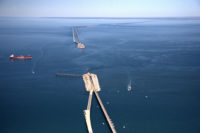Maryland has received federal approval to conduct a Tier 2 NEPA environmental study aimed at identifying an exact location for a new Chesapeake Bay crossing.
The Record of Decision from the Federal Highway Administration endorses the Maryland Transportation Authority’s preferred alternative of locating the new bridge within a two-mile-wide corridor surrounding the existing 4.3-mile dual-span suspension bridge. In addition to being shorter than other alternatives evaluated in MDTA’s Tier 1 study, the selected corridor presented the potential of fewer impacts on both the surrounding communities and environmentally sensitive aquatic resources.
The Tier 1 study, led by RK&K and AECOM, estimated that a bridge in the corridor would cost nearly $9 billion, while a bridge-tunnel option was projected to cost $13 billion.
Incorporating separate spans constructed in 1952 and 1973, the existing tolled crossing serves as the primary highway link to Maryland’s Eastern Shore from the state capital in Annapolis, and metropolitan Washington, D.C., and Baltimore. Capacity issues have grown in step with both development on both sides of the crossing. The average weekday traffic volume of more than 68,500 vehicles nearly doubles in the summer, as millions of visitors use the bridge to access beach resorts in Maryland and Delaware.
Even as the pandemic scaled back the crossing’s traffic volume in early 2020, a westbound deck rehabilitation program launched the previous September nevertheless resulted extensive traffic backups. MDTA worked with the contractor to revise the original construction strategy, accelerating the project’s completion by more than a year. The eastbound span is scheduled to undergo a similar rehabilitation soon.
Still, the prospect of a new bridge in the corridor has been roundly criticized by local residents and officials who fear added crossing capacity will only worsen existing traffic and congestion issues will only worsen
The impacts of a new structure on maritime shipping traffic to and from the Port of Baltimore will also be considered as part of the Tier 2 study. Each of the existing structures provides a 3,200-ft long suspension span over the bay’s western channel with a vertical clearance of 186 feet.
It’s uncertain when the Tier 2 analysis will get underway, as MDTA has not identified a source of funding for the study or the new crossing itself.




Post a comment to this article
Report Abusive Comment